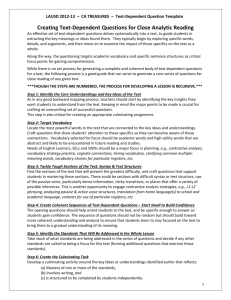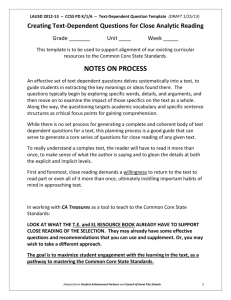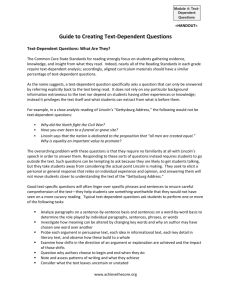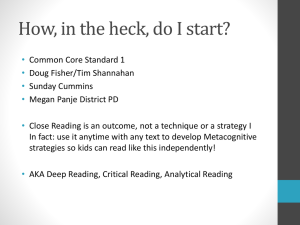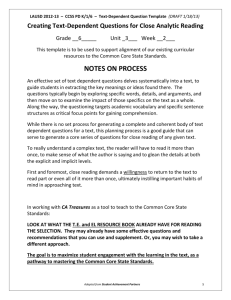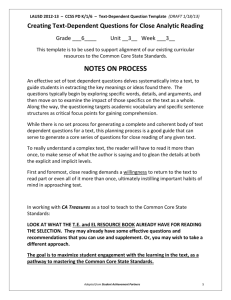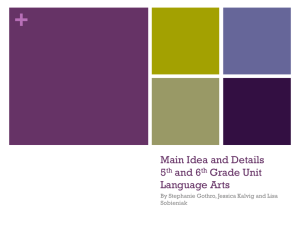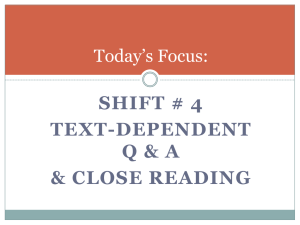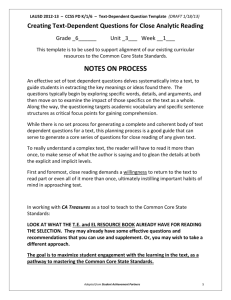1-U1-WK 3
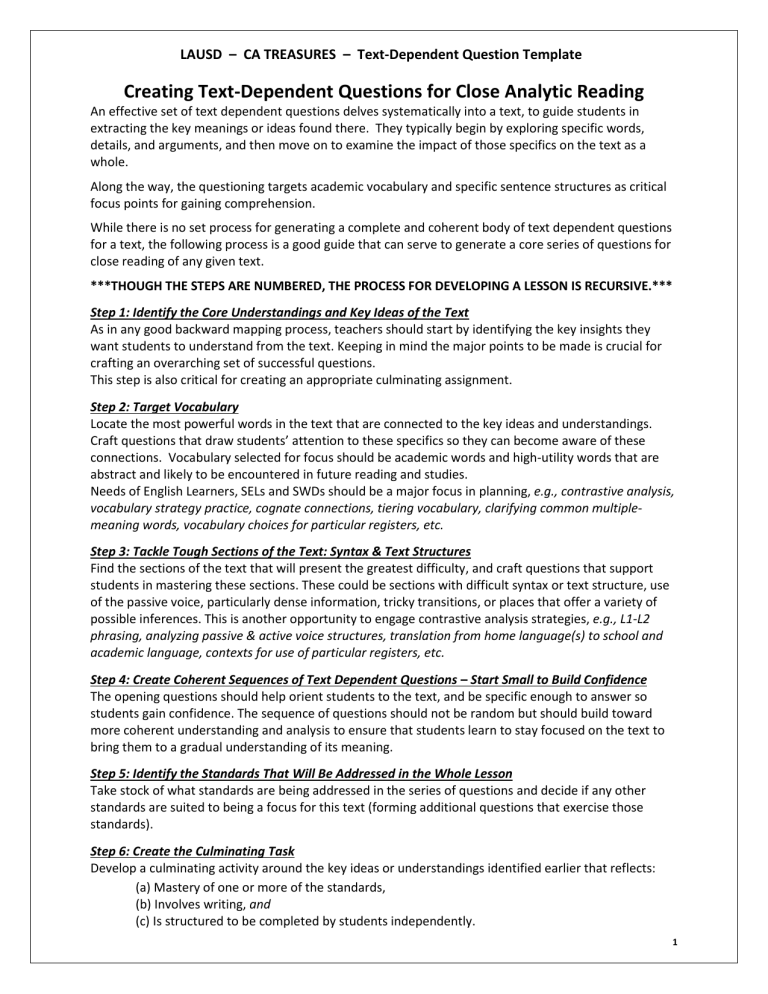
LAUSD – CA TREASURES – Text-Dependent Question Template
Creating Text-Dependent Questions for Close Analytic Reading
An effective set of text dependent questions delves systematically into a text, to guide students in extracting the key meanings or ideas found there. They typically begin by exploring specific words, details, and arguments, and then move on to examine the impact of those specifics on the text as a whole.
Along the way, the questioning targets academic vocabulary and specific sentence structures as critical focus points for gaining comprehension.
While there is no set process for generating a complete and coherent body of text dependent questions for a text, the following process is a good guide that can serve to generate a core series of questions for close reading of any given text.
***THOUGH THE STEPS ARE NUMBERED, THE PROCESS FOR DEVELOPING A LESSON IS RECURSIVE.***
Step 1: Identify the Core Understandings and Key Ideas of the Text
As in any good backward mapping process, teachers should start by identifying the key insights they want students to understand from the text. Keeping in mind the major points to be made is crucial for crafting an overarching set of successful questions.
This step is also critical for creating an appropriate culminating assignment.
Step 2: Target Vocabulary
Locate the most powerful words in the text that are connected to the key ideas and understandings.
Craft questions that draw students’ attention to these specifics so they can become aware of these connections. Vocabulary selected for focus should be academic words and high-utility words that are abstract and likely to be encountered in future reading and studies.
Needs of English Learners, SELs and SWDs should be a major focus in planning, e.g., contrastive analysis, vocabulary strategy practice, cognate connections, tiering vocabulary, clarifying common multiplemeaning words, vocabulary choices for particular registers, etc.
Step 3: Tackle Tough Sections of the Text: Syntax & Text Structures
Find the sections of the text that will present the greatest difficulty, and craft questions that support students in mastering these sections. These could be sections with difficult syntax or text structure, use of the passive voice, particularly dense information, tricky transitions, or places that offer a variety of possible inferences. This is another opportunity to engage contrastive analysis strategies, e.g., L1-L2 phrasing, analyzing passive & active voice structures, translation from home language(s) to school and academic language, contexts for use of particular registers, etc.
Step 4: Create Coherent Sequences of Text Dependent Questions – Start Small to Build Confidence
The opening questions should help orient students to the text, and be specific enough to answer so students gain confidence. The sequence of questions should not be random but should build toward more coherent understanding and analysis to ensure that students learn to stay focused on the text to bring them to a gradual understanding of its meaning.
Step 5: Identify the Standards That Will Be Addressed in the Whole Lesson
Take stock of what standards are being addressed in the series of questions and decide if any other standards are suited to being a focus for this text (forming additional questions that exercise those standards).
Step 6: Create the Culminating Task
Develop a culminating activity around the key ideas or understandings identified earlier that reflects:
(a) Mastery of one or more of the standards,
(b) Involves writing, and
(c) Is structured to be completed by students independently.
1
LAUSD – CA TREASURES – Text-Dependent Question Template
Grade ___1____ Unit __1__ Week ___3__
Core Understandings & Key Ideas of Text
Selection Title: How You Grew
Big Idea for Unit (Unit planning page_vii_): All About Us
Better Big Idea:
What makes you special? What do you like about yourself? What do others like about you?
Selection Concept - Each selection builds to a larger understanding of the Big Idea.
How does this selection connect to the Big Idea?
The selection describes the growth cycle of humans from infants to approximately the readers’ age (6-12 years old).
CCSS Focus Standard(s): Reading Standards for Informational Text
What CCSS literacy standard(s) will you be addressing with this re-read of the selection?
RIT 1: Ask and answer questions to demonstrate understanding of a text, referring explicitly to the text as the basis for the answers.
Essential Question - Connect the CCSS Focus standard to the selection concepts in the form of a question:
What are some things that babies can do? What are some things that infants learn to do?
What are some things that kids learn how to do as they get older?
2
LAUSD – CA TREASURES – Text-Dependent Question Template
Vocabulary & Text Structure
KEY WORDS ESSENTIAL TO
UNDERSTANDING THIS TEXT
Pg Words Clues/Supports
65 changed
65 imitate
65 practice
68 learned
HIGH UTILITY WORDS FOR LANGUAGE
DEVELOPMENT – Words ELs & all students need, to access this and other learning
Pg Words Clues/Supports
71 run photos
71 ride photos
72 be
Pg Words Clues/Supports Pg Words Clues/Supports
67 once other stories, questioning
71 could
On page 66, the title “How You Grew” does not have a question mark. Therefore, the title will provide the answer to the focus question, How do kids change as they get older? A mini lesson on the part of speech that follows the word “how” will teach students to determine if the sentence is a statement or a question.
3
LAUSD – CA TREASURES – Text-Dependent Question Template
Coherent Sequences of Text-Dependent Questions
Text-Dependent Questions Evidence-Based Answers
Read the title and the focus question. How has the little girl on page 66 changed since she was like the baby on page 67?
Read page 67.
What does the word “once” mean?
She can tie her own shoes.
A long time ago, before, one time
Read pp. 68 & 69 as a set before stopping to ask questions.
What are some things kids learn to say when they first learn to talk?
Look at the boy on page 69. How has he changed since he was a baby?
Mama, puppy
He can sit; he can dig
Read pp. 70 & 71 as a set before stopping to ask questions.
How do the photographs help you to see how children are changing?
Do you learn how to eat at the table or ride a bike first? How do you know?
On page 71, the author says, “You could go fast.”
What is the author referring to?
What does the word “could” mean?
The children are getting older on each page; they can do more difficult things
Eat at the table. ( Photos are sequential)
You could run or ride fast.
You might or might not; maybe or maybe not
4
LAUSD – CA TREASURES – Text-Dependent Question Template
Standards Covered in Lesson Sequence
– A single lesson can cover multiple standards
(Reading Informational Text) RIT 1, RIT 3, RIT 4
(Reading Foundational Skills) RFS1b
(Speaking & Listening) SL1a, SL1b, SL3, SL4, SL6
(Language) L4a
(Writing) W3, W8
Culminating Task
– Describe task and steps students will take to achieve them.
Prompt = Teacher instructions to students:
Teacher provides three (3) empty boxes for students to draw sequenced stages in their lives. Students then identify the stages by describing what they learned to do.
Task & Steps:
Students discuss with their partner what they have learned to do thus far.
Students decide on three things to write about.
Students draw pictures of three things they learned to do.
Students write a sentence describing the picture.
Teacher monitors, provides feedback and takes dictation
Students share their drawings and writing with the class
Students ask and answer questions
5
LAUSD – CA TREASURES – Text-Dependent Question Template
Additional Tasks –
(optional) Ex: to supplement or build toward culminating task; provide additional depth, complexity, novelty or acceleration for advanced students; make content connections; etc.
Students gesture with the teacher how they change as they grow (EL Resource p.29)
Students put pictures of children in various developmental stages in sequential order.
Students orally describe pictures of children in various developmental stages with a partner.
Students bring in pictures of themselves as babies, infants, etc. to discuss with a partner.
Students retell the How You Grew using time order words.
Notes to Teacher
Ex: Which sections of text to focus on for particular teaching points; considerations for grouping; content connections, supplemental resources or links
Consider the skill is sequencing and that some students may need as a scaffold additional lessons on the use of time order words to retell a story organized sequentially and/or to write a personal narrative.
6
